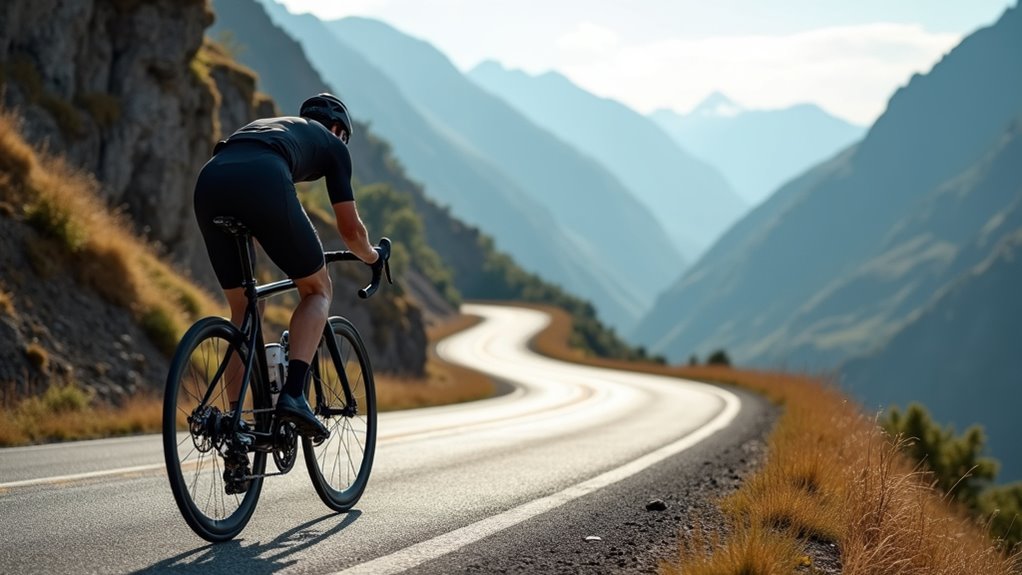Physical Address
304 North Cardinal St.
Dorchester Center, MA 02124
Physical Address
304 North Cardinal St.
Dorchester Center, MA 02124

Transform uphill cycling from a dreaded struggle into an achievable challenge with these proven techniques that every cyclist needs.
You’ve probably felt that familiar burn in your legs when approaching a steep hill, wondering if you’ll make it to the top without walking your bike. Uphill cycling doesn’t have to be a struggle that leaves you gasping and defeated. With the right techniques, gear selection, and mindset, you can transform those intimidating climbs into rewarding challenges. Whether you’re tackling your first hill or looking to improve your climbing efficiency, these proven strategies will change how you approach every ascent.

Before you even begin pedaling toward that intimidating incline, you’ll want to shift into an easier gear that’ll make your climb manageable. Don’t wait until you’re halfway up and struggling—anticipate the grade and downshift early.
Your cadence should feel comfortable, around 70-90 RPMs, allowing your legs to spin rather than grind against heavy resistance.
If you’re riding a multi-speed bike, experiment with different gear combinations during practice rides to find what works best for your fitness level. Lower gears might feel “too easy” at first, but they’ll preserve your energy for the entire climb.
When planning your uphill route, consider choosing trails that minimize your environmental impact by staying on designated paths and avoiding sensitive ecosystems through low impact camping principles.
Once you’ve locked in the right gear, your body becomes the next essential element in conquering that hill. Keep your torso upright and relaxed—hunching forward restricts breathing and wastes energy. Position your hands on the brake hoods for better control and comfort.
Shift your weight slightly forward to maintain traction on the front wheel, but don’t overdo it. Your pedal stroke should stay smooth and circular, not choppy. Focus on pulling up with your hamstrings as much as pushing down with your quads.
Keep your shoulders loose and avoid gripping the handlebars too tightly. This tension travels through your body and saps power. Stay seated when possible—it’s more efficient than standing. Standing should be reserved for short bursts when you need extra power or a brief muscle break.
Just like mastering proper tent camping techniques requires practice and preparation, developing efficient uphill cycling form takes time and consistent effort to perfect.

Perfect body positioning means nothing if you burn out halfway up the climb. You’ll need a pacing strategy that conserves energy while maintaining forward momentum.
Start climbs at 70-80% of your perceived maximum effort. This feels almost too easy initially, but it’s your insurance policy against bonking later. Monitor your breathing—you should be able to speak short sentences without gasping.
Break long climbs into segments. Focus on reaching that next bend or landmark rather than obsessing over the summit. This mental chunking makes intimidating ascents manageable.
Don’t chase other riders early on. Stick to your predetermined effort level, even if others pass you. Many cyclists who start aggressively will fade, and you’ll likely catch them later while feeling strong.
Just like camping safely requires preparation and awareness of your surroundings, successful hill climbing demands understanding your limits and planning accordingly.
While your legs power the pedals, your lungs fuel the engine—and most cyclists don’t breathe efficiently during climbs. You’ll transform your uphill performance by mastering rhythmic breathing patterns that match your pedal strokes.
Start with a 2:2 ratio—inhale for two pedal strokes, exhale for two. As the climb intensifies, shift to 3:3 or even 4:4 patterns. This deliberate approach prevents shallow, panicked breathing that starves your muscles of oxygen.
Focus on belly breathing rather than chest breathing. Your diaphragm should expand outward, not your ribcage upward. Practice this technique on flat roads first, then apply it during climbs.
Don’t hold your breath when the gradient steepens—that’s when you need oxygen most. Keep your breathing steady and controlled, even if you’re grinding through the toughest sections.
Just as you’d pack first aid essentials for camping safety, proper breathing techniques are essential preparation for challenging climbs.

Your breathing rhythm works hand-in-hand with your pedaling tempo, and finding the right cadence can make or break your climb. Aim for 60-80 RPMs when tackling steep inclines – this sweet spot maintains power while preventing your legs from burning out too quickly.
Finding your optimal 60-80 RPM cadence on climbs creates the perfect balance between sustained power output and muscular endurance.
Don’t spin too fast, as you’ll waste energy without generating enough force. Conversely, grinding at low cadences will exhaust your muscles prematurely. Listen to your body and adjust accordingly.
Steeper grades typically require slightly lower cadences, while moderate hills allow for higher RPMs.
Practice shifting gears smoothly to maintain your target cadence as the gradient changes. Use your bike computer or counting method to monitor your pedal strokes.
Consistent cadence keeps you efficient and helps you conquer those challenging climbs successfully. When planning extended climbing adventures, consider investing in custom tent options that perfectly match your specific camping needs and preferences.
Although maintaining proper cadence is essential, mistimed gear shifts can instantly disrupt your climbing rhythm and force you into an energy-sapping recovery.
You’ll want to shift before you actually need easier gears, not when you’re already struggling. Watch the terrain ahead and anticipate steeper sections by shifting down early.
Don’t shift under heavy load – ease off your pedal pressure momentarily during each shift to protect your drivetrain and guarantee smooth transitions.
If you’re using a front derailleur, avoid cross-chaining by keeping your chain line relatively straight.
Practice shifting during training rides to develop muscle memory.
You’ll find that smooth, well-timed shifts maintain your momentum and conserve precious energy for the climb ahead.

When your legs start burning and the summit seems impossibly distant, your mind becomes either your greatest ally or your worst enemy. Mental preparation transforms grueling climbs into manageable challenges.
Break the climb into smaller segments instead of fixating on the entire distance. Focus on reaching the next tree, bend, or landmark rather than the peak. This technique prevents overwhelming feelings and maintains forward momentum.
Develop positive self-talk patterns before you ride. Replace “I can’t do this” with “I’m getting stronger with each pedal stroke.” Practice breathing techniques during training rides to stay calm under pressure.
Visualize successful climbs during rest days. Mental rehearsal builds confidence and familiarity with challenging terrain.
Just as rock climbers must master precise footwork techniques to navigate challenging routes, cyclists need mental precision to conquer steep ascents.
Since your body burns through energy stores rapidly during sustained climbs, proper fueling becomes as crucial as your gear selection. You’ll need strategic nutrition timing to maintain power output throughout long ascents.
Strategic nutrition timing becomes as crucial as gear selection when your body rapidly burns through energy stores during sustained climbs.
Start fueling 2-3 hours before your ride with complex carbohydrates and moderate protein. Think oatmeal with banana or whole grain toast with peanut butter. Avoid heavy, fatty foods that’ll slow digestion.
During climbs lasting over 90 minutes, maintain energy with:
Don’t wait until you’re hungry or exhausted to refuel. Your body needs consistent energy input to conquer those challenging climbs successfully.

While proper nutrition fuels your climbs, targeted training transforms your body into a hill-climbing machine. You’ll want to focus on interval training that mimics uphill conditions. Find a moderate hill and practice repeated climbs at varying intensities – alternate between seated power efforts and standing sprints.
Incorporate tempo rides where you maintain steady effort for 20-30 minutes. This builds the aerobic base you’ll need for longer ascents.
Don’t neglect strength training off the bike either. Squats, lunges, and single-leg exercises develop the muscle power essential for climbing.
Practice your climbing position regularly. Spend time both seated and standing during training rides. Your body needs to adapt to different climbing postures and the unique demands each presents to your muscles and cardiovascular system.
Just like preparing for your first backpacking adventure, developing hill climbing skills requires following a logical progression of training steps to build your capabilities gradually.
Beyond building your physical strength, your bike’s mechanical condition directly impacts your climbing success. A well-maintained bike transfers every ounce of your energy efficiently, making steep ascents feel manageable rather than overwhelming.
Focus on these critical maintenance areas:
Don’t underestimate how much easier climbs become when your bike runs smoothly. You’ll notice the difference immediately – smoother gear changes, less resistance, and more confidence tackling challenging grades.
Regular maintenance isn’t just about bike longevity; it’s your secret weapon for conquering hills. Just like planning the perfect family summer vacation, proper preparation and attention to detail will make your uphill cycling adventures more enjoyable and successful.
Think of uphill biking as conquering your personal mountain—each pedal stroke builds both strength and character. You’ve got the tools now: proper gearing, body positioning, pacing, breathing, cadence, mental toughness, nutrition, training, and bike maintenance. Don’t let those hills overwhelm you anymore. Start with smaller climbs, apply these techniques consistently, and watch your confidence soar. Every challenging ascent you conquer makes the next one easier. You’re ready to turn those formidable climbs into victories.